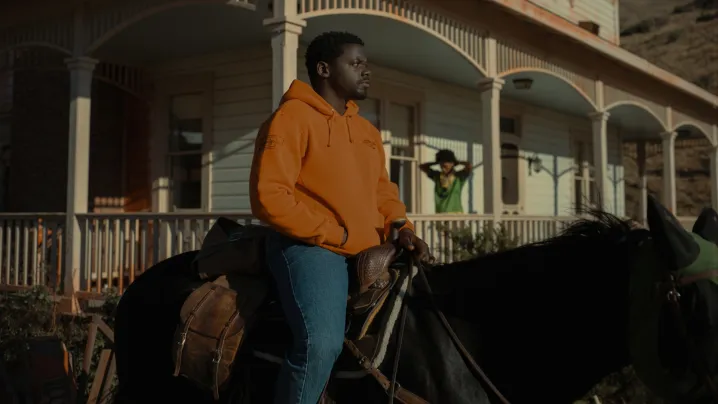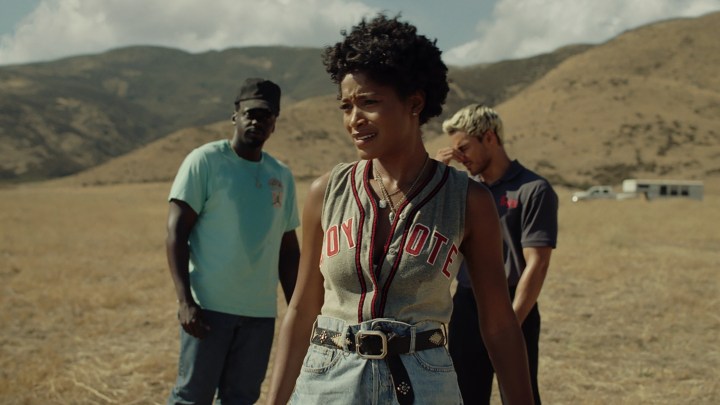The horror genre is in a great place these days, and Nope director Jordan Peele has a lot to do with that success.
Over the last five years, Peele has directed three films, each of them a subversive, twisty spin on a particular subgenre of horror. His directorial debut, 2017’s Get Out, was a Hitchcock-esque thriller steeped in the all-too-real terror of systemic racism, while 2019’s Us was an exploration of xenophobia and privilege wrapped in a home-invasion slasher.
With Nope, Peele dives into the sci-fi corner of the genre, delivering a tale of extraterrestrial terror packed with powerful symbolism, potent scares, and tremendous performances from its cast.

Written and directed by Peele, Nope casts Get Out star Daniel Kaluuya and Keke Palmer as siblings OJ and Emerald Haywood, respectively, descendants of the jockey depicted in the 1878 short film The Horse in Motion, regarded as one of the earliest examples of a motion picture. The Haywoods now manage a ranch where they train horses to appear in films, but after their father is mysteriously killed by debris falling from an aircraft, the ranch falls into debt. The pair’s troubles are amplified by a series of horse disappearances and strange events that lead them to discover a strange, airborne object hovering over the region that might hold the answer to various mysteries and their own financial woes.
Like Get Out and Us before it, Nope is a film best experienced unspoiled, knowing as little about where the story takes its characters as possible. Peele is a master of tweaking the familiar in fresh, unexpected ways that turn a conventional story into something far deeper and more thought-provoking than anticipated. Nope continues that trend, and not only toys with traditional, sci-fi horror tropes, but offers a completely new lens to view them through. It’s a story you can’t help thinking about long after the credits roll, despite delivering a thoroughly satisfying conclusion to the Haywood’s ordeal.

Portraying a world-weary rancher’s son who filters every experience through the lessons taught by both his father and the horses he’s raised and trained, Kaluuya is the driving force in Nope, often conveying as much with his eyes as he does with his words and actions. After bringing him into the spotlight in Get Out, Peele clearly knows how much Kaluuya brings to a scene and how to use the camera to capture every bit of it. His performance is the vehicle for much of the heart, the horror, and the heroism in the film, and Kaluuya handles all of it with the nuance and talent that makes him so fascinating to watch.
Palmer also delivers a memorable performance in Nope, portraying OJ’s flakey-but-loyal sister who sees opportunity in every obstacle and pushes OJ out of his comfort zone. Her character’s from-the-start fearlessness is something we don’t often see in films of this ilk (which are often filled with predictably dumb characters making predictably dumb decisions), and it fills every creepy encounter with potential, as you’re never quite certain how she’ll react or in which unexpected direction she’ll push herself and her brother.

While Nope takes a Spielberg-like approach to its alien-encounter story, full of teasing moments punctuated by cathartic, cinematic spectacle, it also channels M. Night Shyamalan’s polarizing 2002 extraterrestrial-horror film Signs at times.
Like Signs, Nope is layered with symbolism, foreshadowing, and callbacks to its own mythology, often with a heavier hand than Peele typically employs in his films. Seemingly minor plot points come back in big ways to deliver important revelations key to characters’ survival, with OJ frequently finding very specific, alien-applicable wisdom in his father’s lessons about training horses, for example. That sense of everything being intentional and important in the film — every song, every word, every piece of set decoration — looms large over Nope, and it creates the sort of experience that makes the idea of multiple, scrutinized viewings of the film appealing.

Nope is a much smarter film than Signs, however, from its careful, cautious handling of what its characters can possibly know about the mysteries and entity they encounter, to the way those encounters are depicted and the experiences that inform their actions. As its title suggests, the inclination to run as fast as possible in the opposite direction when presented with something terrifying is strong, and the path the characters take to get where they are in the film’s finale — and the decisions they make — feel earned and supported by everything we’ve learned about them to that point.
The film also delivers one of the most fascinating depictions of otherworldly entities we’ve seen on the big screen in quite a while (possibly since 2016’s Arrival), and offers a great reminder of the importance of outside-the-box thinking when it comes to presenting something as unknowable (at this point, at least) as extraterrestrial life-forms.
Peele certainly set a high bar for himself with Get Out, but he somehow manages to keep raising it with each film he directs. Nope doesn’t offer the same subtle, psychological terror of Get Out or the disturbing, killer-outside-your-door scares as Us, and instead makes it clear that Peele isn’t interested in making the same film over and over again. His third film blends wonder and danger in a way that makes it feel like a summer tentpole feature at times — especially with some of its gloriously cinematic moments — but it still retains the sense of slowly creeping dread that’s become a signature of his films, thanks to Peele’s singular vision and Nope‘s talented cast.
Written and directed Jordan Peele, Nope is in theaters now.



